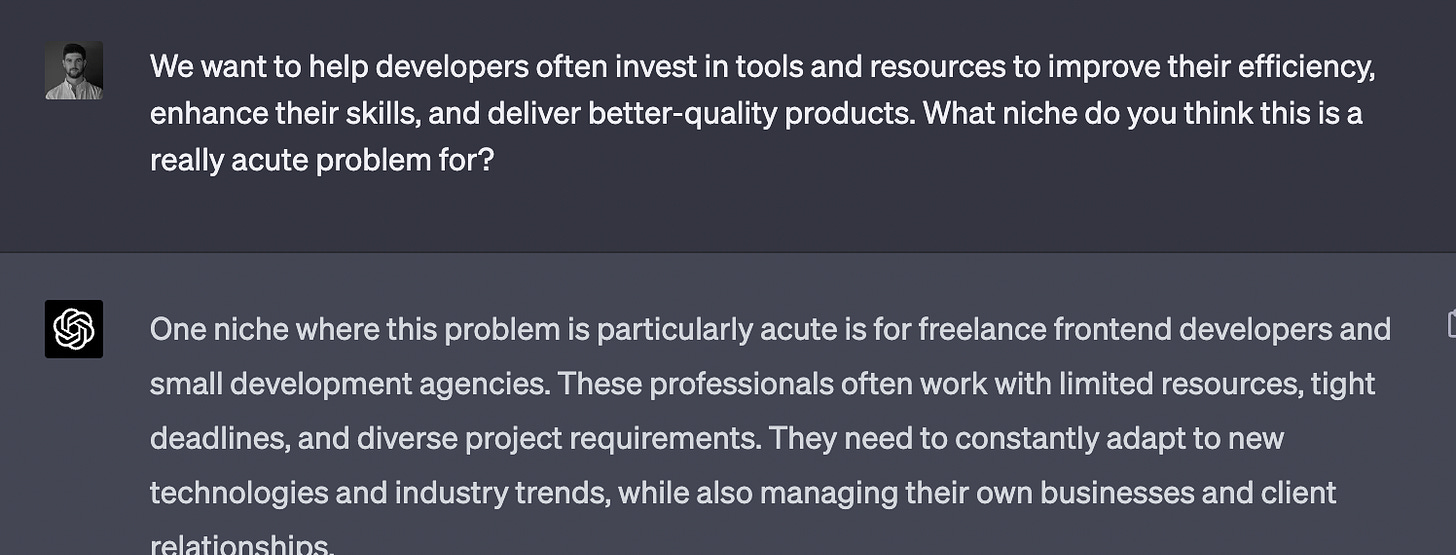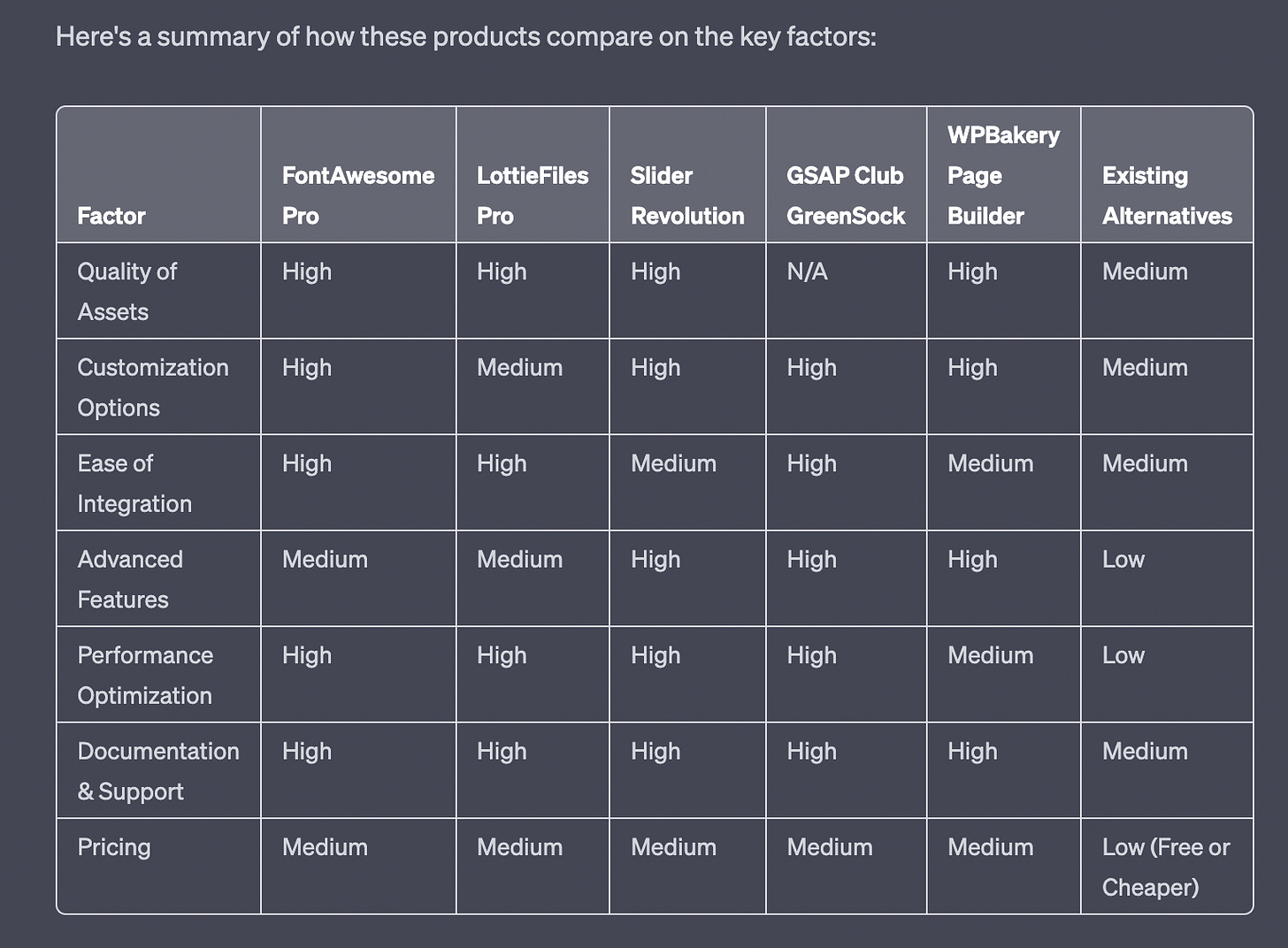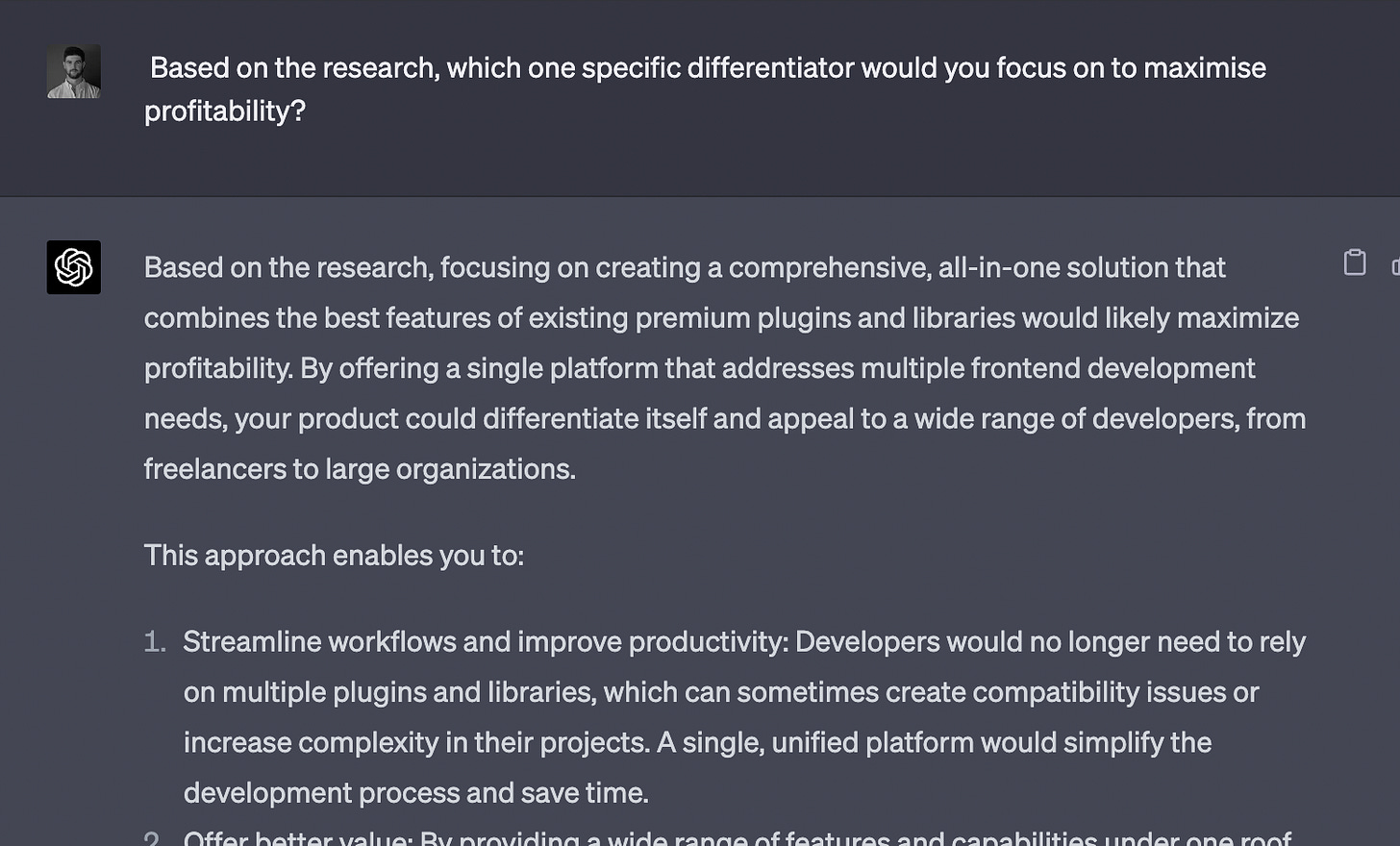8 Powerful ChatGPT Prompts to Discover New Product Opportunities
In this article, I’m going to outline the key steps you can follow to use ChatGPT to help you dramatically improve existing product offers - or to discovery new product opportunities.
It is, however, important to remember: ChatGPT is an assistant. Use these prompts as a tool to help you generate ideas, stress-test your thinking & trigger new insights. It does not - nor should it - replace your human creativity & analytical thinking.
Let’s jump in:
1/8 Provide context first.
For an existing product, it is essential to start with context. The more context you provide to ChatGPT about the product, the better quality the responses. Here’s a simple template to start:
My product solves [insert problem]. Our target audience is [insert target audience]. Our unique value proposition is [insert UVP]
2/8 We want to solve [the problem]. Which niche do you think [the problem] is most acute for? Why? Are there any other niches we currently don't focus on that suffer acutely from this problem?
Whether you are launching a new - or working on an existing - product, selecting the right market will set you up for success or failure. It’s therefore important to think of different target markets you could focus on. ChatGPT can be a powerful way to generate new ideas, or simply stress-test the niches you are currently focus on to see whether these do, in fact, make sense.
It can come up with some powerful results. For my problem of “helping people find their first property”, for example, it suggested military personnel as a target niche with high disposable income & lack of knowledge around the problem.
3/8 What are the 10 most common products [this niche] spends money on to solve [this problem]? How much do they spend on each product on average?
This prompt allows us to get a good sense of the competitive market very quickly. Furthermore, by asking about actually spend per user, we get a better sense of who our true competition is: the products that are good enough for users to actually pay for.
That can help inform our product strategy about what to build (and what not to build) in order to achieve profitability.
Although not a comprehensive overview of the market, this prompt is a very good starting point when you want to get a rough idea of the competitive landscape.
4/8 What are the 5 most popular existing products [used within product category] for [the niche]? What's the main thing each of them does well?
Beyond just understanding which products are used by our target market, it’s more important to understand why they are used. That means digging in to the specific use cases & core value of these products.
If we understand what kind of goals motivate a user to take action, we can try to think of different, ideally better ways to achieve those goals. That’s the foundational of a differentiated product strategy i.e. one that our users will actually pay attention to.
5/8 Create a Blue Ocean Strategy Canvas for this market with these competitors & existing alternatives? Suggest possible areas of Blue Ocean for my new product
At this stage we have a rough sense of the market - some of the main players and what they do well. Next, we want to create a more comprehensive view of the market.
That’s where the Blue Ocean Strategy Canvas comes in. A Blue Ocean Strategy Canvas is a visual tool that helps identify areas of competition and potential untapped market spaces. It’s a powerful tool to help visualise the competitive landscape, as well to align stakeholders around.
ChatGPT can also create a table of this data if you ask: “Put the data in a table”.
6/8 Based on the research, which specific differentiator would you focus on to maximise user & business value?
Through the Blue Ocean framework, ChatGPT can suggest some interesting ways you could differentiate the product.
However, it doesn’t understand constraints. For example, it might suggest you try and do 10 different things way better than the competition (almost always a losing strategy), rather than focusing on one specific area of value to dominate (a winning strategy).
That’s where follow-up questions can help you dig in & understand why a certain differentiator might be important to your strategy. It may also simply help unlock your own creativity to come up with related, or entirely different ideas.
7/8 What are the 5 main risks you could see with this product? Please focus on viability, feasibility & usability risks
There’s so much to think about when it comes to product management that we inevitably forget things.
Risk, however, lies at the heart of our roles as PMs. Use ChatGPT to stress-test your product roadmap, your strategy, your discovery work. Whatever it is. By seeing risks upfront, we can address &, in many cases, avoid them.
Because ChatGPT is trained on a lot of historic data (including startup/product failure data), it is particularly good at risk identification.
8/8 If I were to work on this product as a business, is there anything important we haven't thought of?
Open questions rarely work with AI, as we need to usually hold its hand. In this case, however, it may nudge you to think about key parts of the product strategy you may have forgotten or ignored.
I hadn’t, for example, thought about the possibility of creating strategic partnerships as part of the product strategy.
Summary
Give context: problem, audience, current unique value prop (if it exists)
Our product focuses on solving [the problem] for these 3 niches: [add list of niches your product currently focuses on]. Which niche do you think [the problem] is most acute for? Why? Are there any other niches we currently don't focus on that suffer acutely from this problem?
What are the 10 most common products [this niche] spends money on to solve [this problem]? How much do they spend on each product on average?
What are the 5 most popular tools [used within product category]? What's the main thing each of them does well?
Create a Blue Ocean Strategy Canvas for this market with these competitors & existing alternatives? Suggest possible areas of Blue Ocean for my new product
Based on the research, which specific differentiator would you focus on to maximise user & business value?
What are the 5 main risks you could see with this product? Please focus on viability, feasibility & usability risks
If I were to work on this product as a business, is there anything important we haven't thought of?










